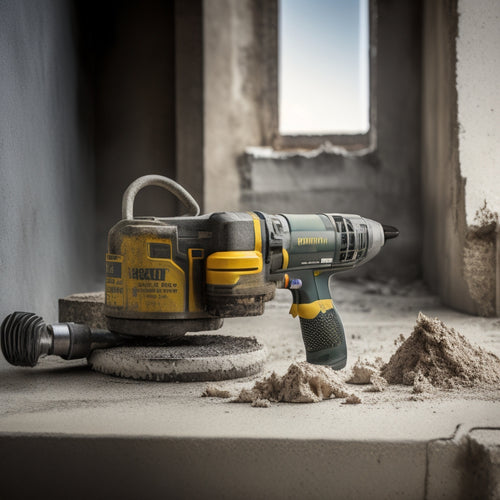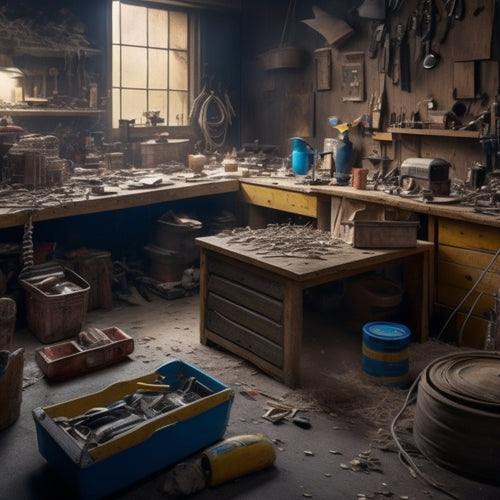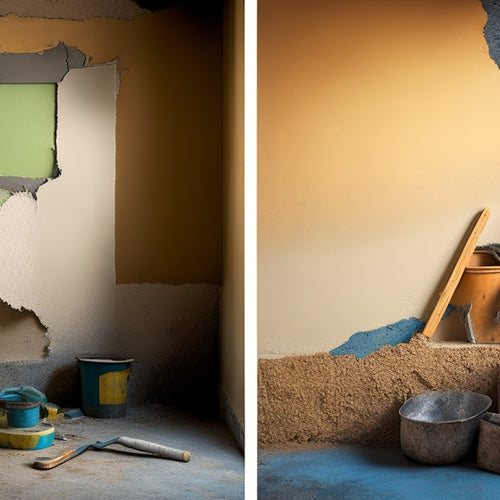
3 Beginner-Friendly Tools for Plaster Renovation Success
Share
You'll be glad to know that the three essential tools you need for a successful plaster renovation are the same ones professionals rely on. Start with a sturdy mixing bucket and mixing stick for efficient mixing, then move on to a high-quality trowel for applying and smoothing the plaster. Finally, a putty knife is a must-have for scraping and finishing surfaces. With these three beginner-friendly tools in your arsenal, you'll be well on your way to achieving a professional-looking finish - and that's just the beginning of what you can accomplish with the right techniques and expertise at your fingertips.
Key Takeaways
• A sturdy mixing bucket and mixing stick are essential for efficient mixing and a professional finish in plaster renovation.
• A high-quality trowel is a must-have for applying plaster smoothly and evenly, especially for beginners.
• A putty knife is necessary for scraping and smoothing surfaces, and its maintenance is crucial for effective use.
• A hawk tool aids in holding and carrying plaster, making it easier to work with, especially for those new to plaster renovation.
• Mastering the use of these tools and following proper techniques can help beginners achieve a smooth, professional-looking finish.
Essential Tools for Plastering
You'll need a thorough set of high-quality tools to achieve a professional-looking finish and assure a successful plastering project. A sturdy mixing bucket, mixing stick, and trowels are must-haves for efficient plaster mixing and application.
Invest in a hawk, a tool used to hold and carry plaster, to streamline your workflow. Don't forget a putty knife for scraping and smoothing out surfaces.
To guarantee your tools remain in top condition, prioritize tool maintenance. Regularly clean and dry your trowels to prevent rust and maintain their non-stick coating.
Sharpen your putty knife regularly to maintain its effectiveness. Store your tools in a dry, organized space to prevent damage and prolong their lifespan.
A well-maintained set of tools won't only enhance your work quality but also reduce the risk of accidents and injuries. By investing in the right tools and maintaining them properly, you'll be well-equipped to tackle even the most demanding plastering projects with confidence.
Mastering Plaster Ceiling Repair
When tackling plaster ceiling repair, accurately evaluating the damaged area is vital to determining the best course of action and preventing further deterioration.
You'll need to perform a thorough crack assessment to identify the type and extent of the damage. This involves examining the crack's length, width, and depth to determine if it's a hairline crack or a more significant issue.
Once you've assessed the damage, you can begin cleaning the area to remove any debris or dust. Next, you'll need to apply a bonding agent to guarantee a strong bond between the old and new plaster.
Using the right texture techniques is fundamental to achieving a seamless repair. You may need to recreate the original texture using a combination of troweling, floating, and finishing techniques.
It's important to practice these techniques on a small, inconspicuous area first to confirm you get it right. By following these steps and using the right tools, you'll be well on your way to mastering plaster ceiling repair.
Remember to work methodically, taking your time to confirm each step is completed correctly before moving on to the next.
Achieving Smooth Finishes Easily
Achieving Smooth Finishes Easily
To achieve a smooth, even finish, it is essential to select the right plaster renovation tools and master the techniques for applying and finishing plaster correctly. As a beginner, you'll want to focus on developing effective smoothing techniques to achieve a professional-looking result. One key aspect is using the right type of finishing trowel, which should be specifically designed for plaster renovation.
| Tool | Description | Benefit |
|---|---|---|
| Finishing Trowel | Used for final smoothing and finishing | Produces a smooth, even surface |
| Plaster Rake | Used for applying and spreading plaster | Allows for quick and even application |
| Plaster Edger | Used for creating clean edges and corners | Prevents plaster from spreading beyond boundaries |
When it comes to applying and finishing plaster, using quick-drying products can greatly reduce the time spent on the project. Look for products labeled as 'quick-drying' or 'fast-setting,' which can be walked on or recoated within a few hours. By combining the right tools and techniques, you'll be able to achieve a smooth, even finish that looks professional and lasts for years to come.
Frequently Asked Questions
What Safety Gear Is Necessary for Plaster Renovation Projects?
When tackling plaster renovation projects, you'll need to prioritize your safety above all else.
You're working with dusty, potentially hazardous materials, so don't skip on the essentials.
You'll need safety goggles to protect your eyes from debris and dust, and a respirator mask to filter out harmful particles from the air.
These must-haves will shield you from avoidable injuries and respiratory issues, ensuring you can power through your project with confidence and precision.
How Do I Handle Unexpected Electrical or Plumbing Issues?
When you're knee-deep in plaster dust, unexpected electrical or plumbing issues can be a ticking time bomb.
Don't get caught off guard - be prepared to call in the cavalry. Before you start demo, consider hiring a pro for electrical inspections to identify potential hotspots.
And, have a plan B for plumbing alternatives, like temporary shut-offs or rerouting.
Stay one step ahead of surprises and keep your project on track.
Can I Reuse Old Plaster or Must It Be Replaced Entirely?
When evaluating old plaster, you'll need to gauge its integrity to determine if it can be reused or requires replacement.
Inspect the surface for cracks, water damage, or signs of deterioration. If the damage is extensive, it's best to replace the plaster entirely to guarantee a stable substrate for your renovation.
However, if the plaster is still intact, you can use advanced renovation techniques to restore it, saving time and resources.
What Are the Best Practices for Cleaning up Plaster Dust?
When tackling plaster renovation, you'll inevitably face the challenging task of cleaning up plaster dust.
To master this essential step, you'll need to employ effective dust control measures. Start by sealing off the work area with plastic sheets and tape to contain the mess.
Next, use a vacuum with a HEPA filter to capture fine particles. Finally, wipe down surfaces with a damp cloth to prevent dust from becoming airborne.
Are There Any Specific Building Codes I Need to Follow?
When tackling a plaster renovation, you'll need to comply with local building regulations.
Research the specific codes and ordinances in your area to guarantee you're meeting the necessary standards.
You'll likely require local permits, so factor those into your project timeline and budget.
Don't risk fines or project delays - take the time to understand and adhere to the regulations that govern your renovation.
Conclusion
As you wrap up your plaster renovation project, it's not a coincidence that the results are stunning - it's a direct result of using the right tools for the job.
With the essential tools for plastering, mastering plaster ceiling repair, and achieving smooth finishes easily, you've set yourself up for success.
Now, take a step back and admire your handiwork, knowing that your hard work and attention to detail have paid off.
Related Posts
-

Top Drill for Concrete Wall Renovation
When choosing the top drill for your concrete wall renovation, you'll want to prioritize key features like drill powe...
-

Why Delay Your Renovation With Poor Tool Management
You're likely unaware that poor tool management is a leading cause of renovation delays, and it's not just about havi...
-

Top 3 Tools to Buy for Stucco Renovation
You'll need the right tools to guarantee a successful stucco renovation, and it all starts with three essential items...


